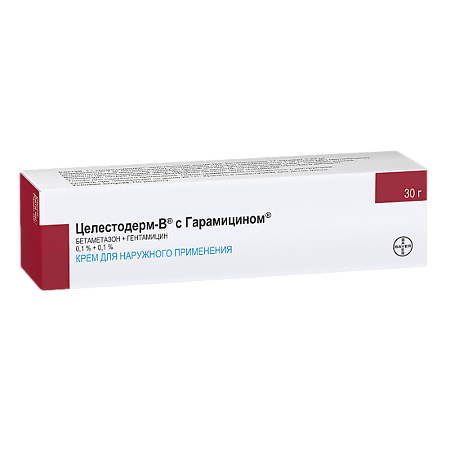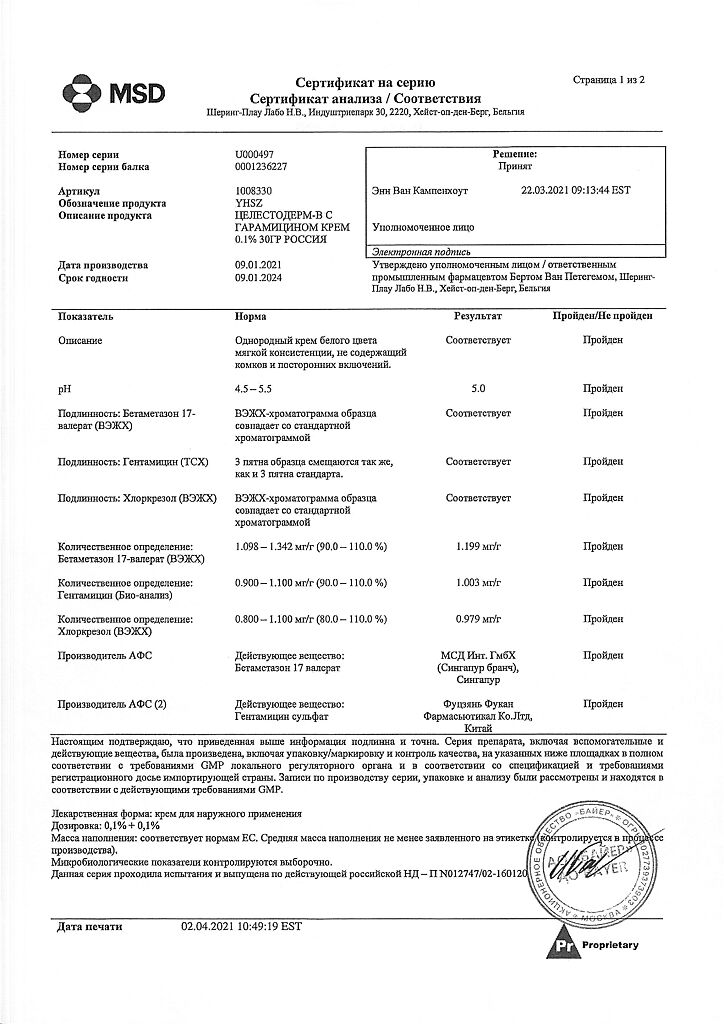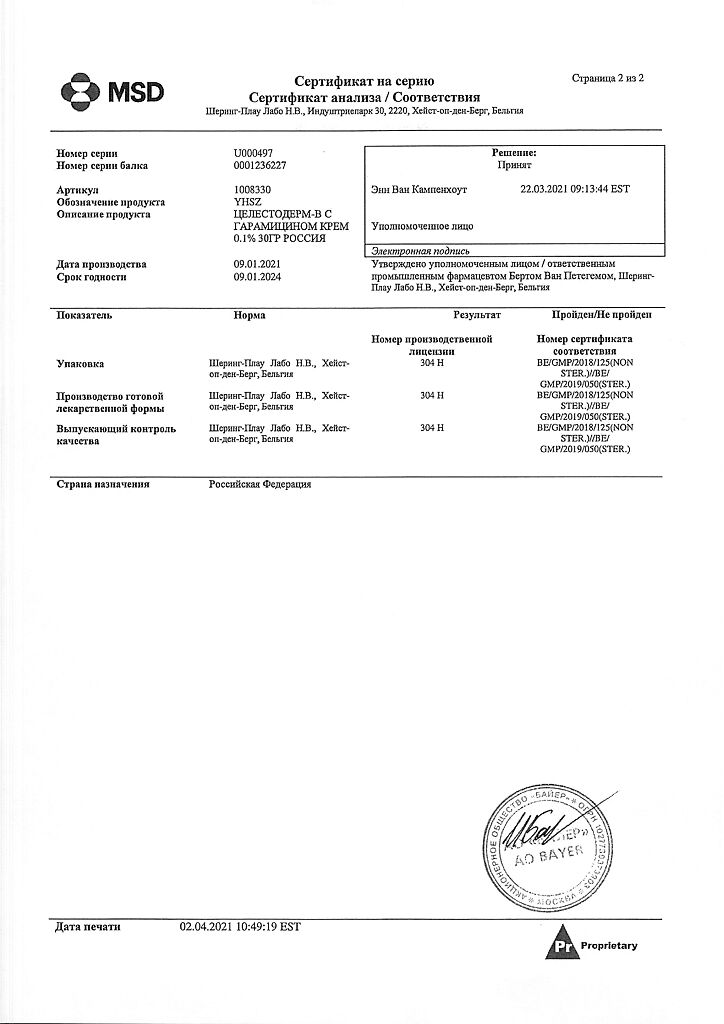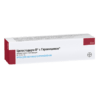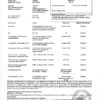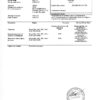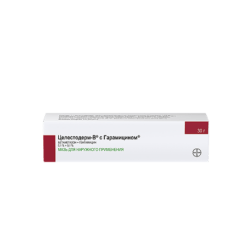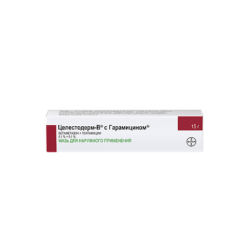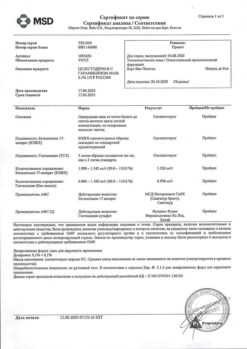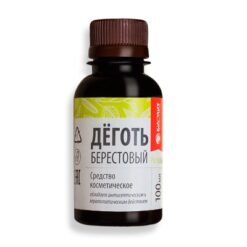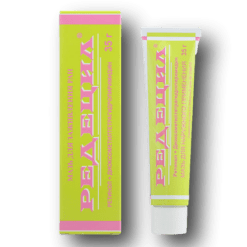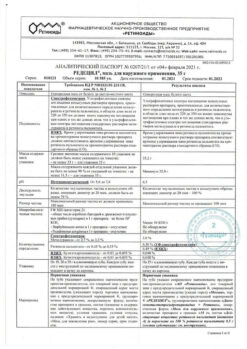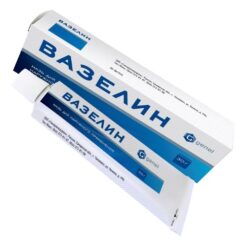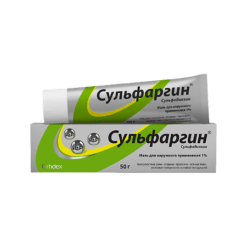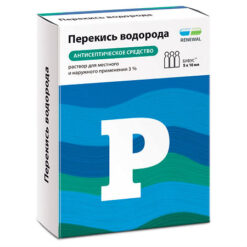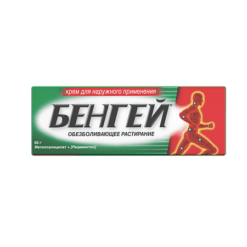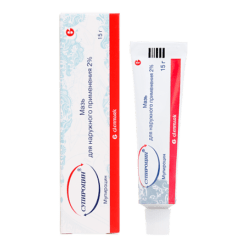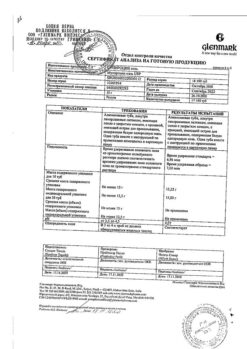No products in the cart.
Celestoderm B with Garamycin, cream 0.1% 30 g
€22.49 €18.74
Description
Pharmgroup: antibiotic aminoglycoside + glucocorticosteroid.
Pharmacological action: Celestoderm-B with Garamycin is a combination drug whose action is due to the components in its composition. < Betamethasone valerate - GKS - has anti-inflammatory and anti-allergic effect, inhibits the release of cytokines and inflammatory mediators, reduces the metabolism of arachidonic acid, induces the formation of lipocortins, which have anti-edema activity, reduces vascular permeability.
Gentamicin, a broad-spectrum antibiotic, is effective against the majority of common pathogens when applied topically.
The bacteria susceptible to gentamicin include sensitive strains of streptococcus (beta-hemolytic, alpha-hemolytic), Staphylococcus aureus (coagulase-positive, coagulase-negative and some penicillinase-producing strains) and Gram-negative bacteria: Pseudomonas aeruginosa, Aeobacter aerogenes, Escherichia coli, Proteus vulgaris and Klebsiella pneumoniae.
Indications
Indications
Local treatment of skin diseases amenable to GCS therapy, in the presence of a secondary infection caused by microorganisms susceptible to gentamicin, or if such an infection is suspected:
– eczema (atonic, childhood, coin-shaped);
— contact dermatitis;
— seborrheic dermatitis;
— neurodermatitis;
– solar dermatitis;
— exfoliative dermatitis;
— radiation dermatitis;
– diaper rash;
— psoriasis;
– anogenital and senile itching.
Celestoderm-B ointment with garamycin is used for skin lesions due to eczema or psoriasis, and cream is used for diseases of moist or oily skin.
Pharmacological effect
Pharmacological effect
Pharmaceutical group: antibiotic aminoglycoside + glucocorticosteroid.
Pharmaceutical action: Celestoderm-B with garamicin is a combination drug, the effect of which is determined by the components included in its composition.
Betamethasone valerate – GCS – has an anti-inflammatory and antiallergic effect, inhibits the release of cytokines and inflammatory mediators, reduces the metabolism of arachidonic acid, induces the formation of lipocortins, which have anti-edematous activity, and reduces vascular permeability.
Gentamicin, a broad-spectrum antibiotic, is effective against most common pathogens when applied topically.
Bacteria susceptible to gentamicin include sensitive strains of streptococcus (beta-hemolytic, alpha-hemolytic), Staphylococcus aureus (coagulase-positive, coagulase-negative and some penicillinase-producing strains), as well as gram-negative bacteria: Pseudomonas aeruginosa, Aerobaster aerogenes, Escherichia coli, Proteus vulgaris and Klebsiella pneumoniae.
Special instructions
Special instructions
Celestoderm B is not intended for use in ophthalmology.
When using the drug on large surfaces and/or with an occlusive dressing, it is necessary to keep in mind the possibility of systemic action of betamethasone, as well as the development of the following side effects: maceration of the skin, secondary infection, skin atrophy, stretch marks, prickly heat.
If drug-resistant bacterial and fungal microflora appears, use of the drug should be discontinued and appropriate therapy should be prescribed.
Use in pediatrics
The drug is prescribed to children only according to strict indications and under medical supervision, because it is possible to develop systemic side effects associated with betamethasone: suppression of the function of the hypothalamic-pituitary-adrenal system and the development of symptoms of hypercortisolism. In addition, there may be a decrease in the excretion of growth hormones, as well as an increase in intracranial pressure.
Active ingredient
Active ingredient
Betamethasone, Gentamicin
Composition
Composition
Active substances:
– betamethasone 17-valerate – 1.22 mg (equivalent to 1 mg betamethasone)
– gentamicin sulfate (gentamicin equivalent) 1 mg (1000 IU).
Excipients: white soft paraffin – 150 mg; cetostearyl alcohol – 72 mg; liquid paraffin – 60 mg; macrogol cetostearyl ether – 22.5 mg; phosphoric acid – 0.02 mg; sodium dihydrogen phosphate dihydrate – 3.39 mg (equivalent to 3 mg sodium dihydrogen phosphate monohydrate); chlorocresol – 1 mg; sodium hydroxide and phosphoric acid – until pH is established; purified water – q.s. up to 1 year
Pregnancy
Pregnancy
Due to the fact that the safety of the use of local corticosteroids in pregnant women has not been established, the prescription of drugs of this class during pregnancy is justified only if the benefit to the mother clearly outweighs the possible harm to the fetus.
GCS should not be used during pregnancy for a long time or in large doses.
Since it has not yet been established whether GCS, when applied topically and systemically absorbed, can penetrate into breast milk, a decision should be made to stop breastfeeding or discontinue the drug, taking into account how necessary its use is for the mother.
Contraindications
Contraindications
– Hypersensitivity to any of the components of the drug.
– Skin tuberculosis.
– Skin manifestations of syphilis.
– Chicken pox.
– Simple herpes.
– Fungal skin diseases.
– Vaccination period and post-vaccination skin reactions.
– Lactation period.
– Pregnancy (long-term treatment of large areas of skin).
– Children up to 6 months.
With caution:
– Pregnancy (in the absence of criteria for contraindications), especially in the 1st trimester.
– Long-term treatment of large areas of skin, especially in children. – If there are cracks in the skin or if occlusive dressings are used.
Side Effects
Side Effects
Local reactions: skin irritation (itching, erythema), burning sensation, dry skin, folliculitis, hypertrichosis, acne, hypopigmentation, perioral dermatitis, allergic contact dermatitis. When using occlusive dressings: skin maceration, secondary infection, skin atrophy, stretch marks, prickly heat.
With prolonged treatment or application to a large surface: the development of systemic side effects characteristic of GCS is possible: weight gain, osteoporosis, increased blood pressure, edema, ulceration of the gastrointestinal mucosa, exacerbation of hidden foci of infection, hyperglycemia, agitation, insomnia, menstrual irregularities.
Children receiving local corticosteroids may experience the following side effects: suppression of the function of the hypothalamic-pituitary-adrenal system, Cushing’s syndrome, growth retardation, delayed weight gain, increased intracranial pressure.
Symptoms of adrenal suppression in children include decreased plasma cortisol levels and lack of response to ACTH stimulation. Increased intracranial pressure is manifested by bulging of the fontanel, headache, and bilateral papilledema.
Overdose
Overdose
Symptoms: excessive or prolonged use of local corticosteroids can cause inhibition of the function of the pituitary-adrenal system, which can cause the development of secondary adrenal insufficiency and the appearance of symptoms of hypercortisolism, including Cushing’s syndrome. A single overdose of gentamicin is not accompanied by the appearance of any symptoms. Long-term use in doses exceeding the recommended ones can lead to a significant growth of insensitive flora, including fungal flora, in the affected area.
Treatment: Appropriate symptomatic treatment is indicated. Acute symptoms of hypercortisolism are usually reversible. If necessary, correction of electrolyte imbalance is indicated. In case of chronic toxic effects, gradual withdrawal of GCS is recommended. If the growth of microorganisms is uncontrolled, appropriate antibacterial or antifungal treatment should be selected.
Storage conditions
Storage conditions
Store at a temperature not exceeding 25°C.
Manufacturer
Manufacturer
Schering-Plau Labeau N.V., Belgium
Additional information
| Conditions of storage | Store at a temperature not exceeding 25 ° C. |
|---|---|
| Manufacturer | Schering-Plough Labo N.V., Belgium |
| Medication form | exterior cream |
| Brand | Schering-Plough Labo N.V. |
Other forms…
Related products
Buy Celestoderm B with Garamycin, cream 0.1% 30 g with delivery to USA, UK, Europe and over 120 other countries.

